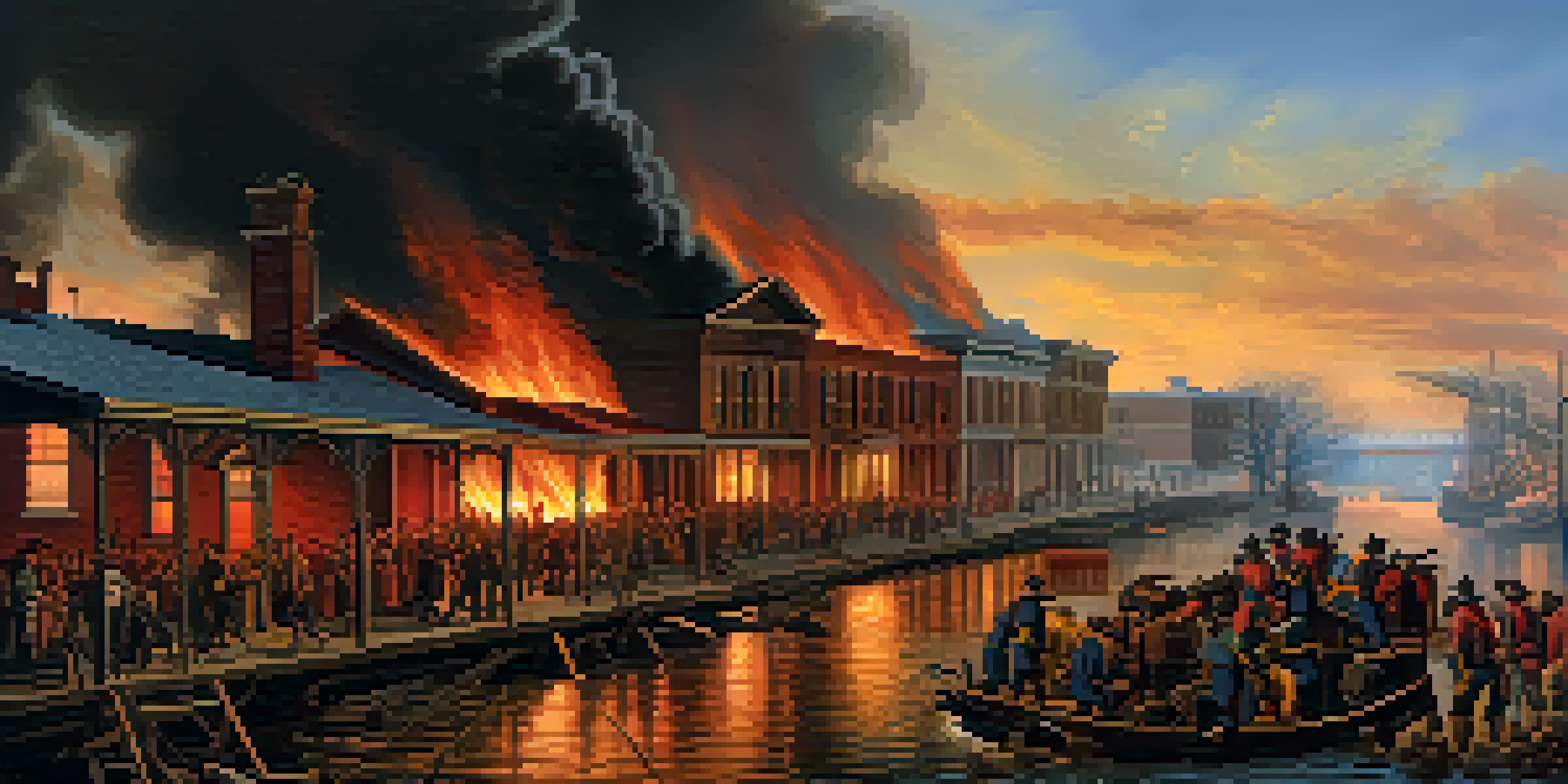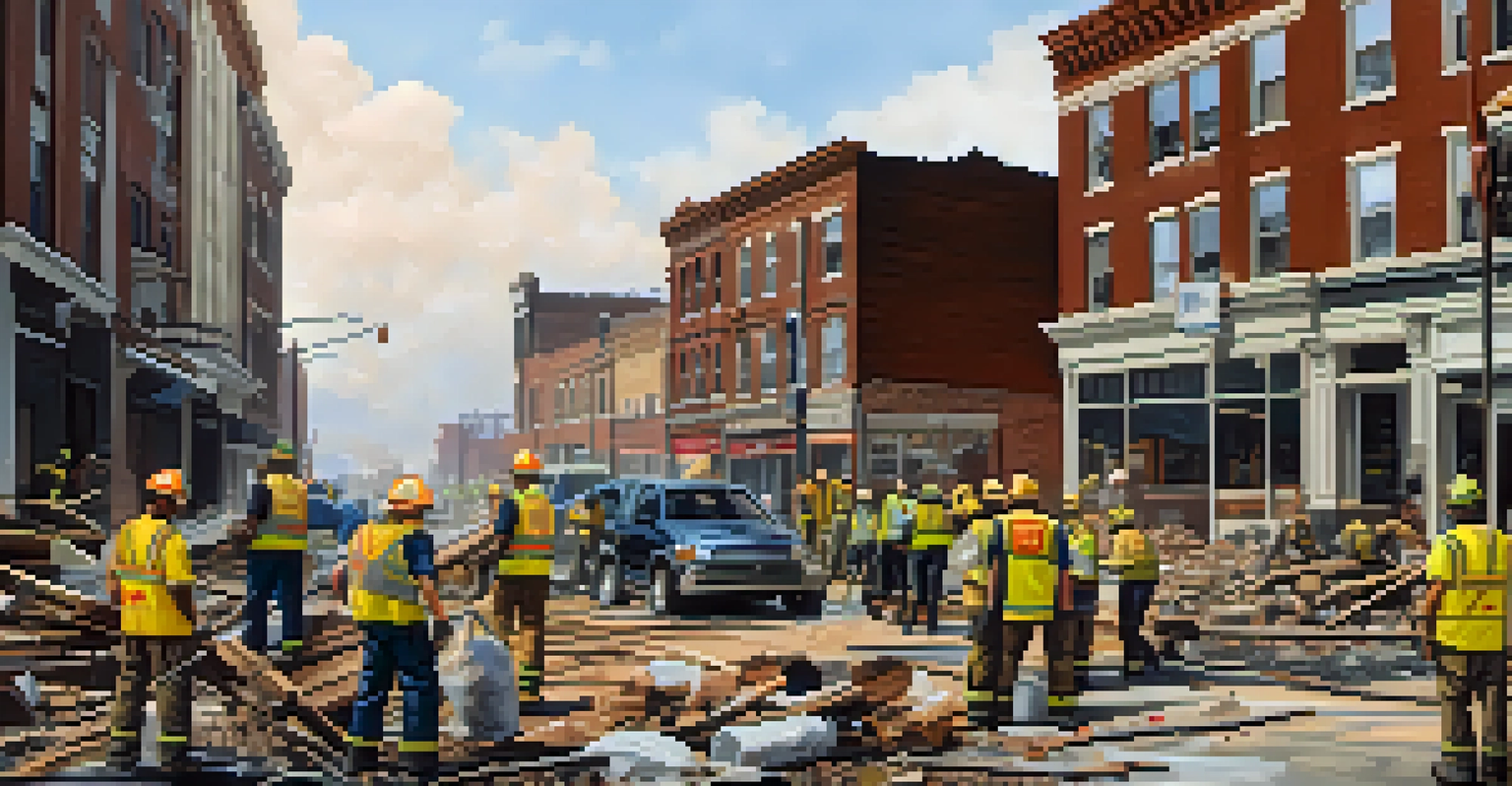The Great St. Louis Fire of 1849: Causes and Impact

Overview of the Great St. Louis Fire of 1849
The Great St. Louis Fire of 1849 was a devastating event that reshaped the city. Occurring on May 27, the fire rapidly spread, destroying a significant portion of St. Louis. This disaster serves as a pivotal moment in the city's history, highlighting the vulnerabilities of urban areas to fire hazards.
The greatest glory in living lies not in never falling, but in rising every time we fall.
The fire was ignited in a warehouse near the riverfront, where wooden structures were prevalent. With dry weather conditions and strong winds fanning the flames, the fire quickly spiraled out of control. It consumed over 15 blocks, impacting thousands of residents and businesses.
This catastrophic event not only changed the landscape of St. Louis but also prompted discussions on fire safety and urban planning. As we delve deeper into the causes and impacts of the fire, we can better understand its lasting significance.
The Causes of the Great St. Louis Fire
Several factors contributed to the outbreak of the Great St. Louis Fire, starting with the city's construction materials. During this period, many buildings were constructed primarily from wood, making them highly susceptible to fire. This choice of materials, combined with the close proximity of structures, created a perfect storm for a fire disaster.

Additionally, the weather conditions at the time played a crucial role. A drought had made the surrounding area incredibly dry, while strong winds helped to spread the flames rapidly. These environmental factors significantly exacerbated the fire's intensity and speed.
Fire Led to Urban Planning Changes
The Great St. Louis Fire prompted stricter building codes and fire safety measures to prevent future disasters.
Lastly, firefighting resources were limited and poorly organized during this time. The local fire department faced challenges in mobilizing equipment and personnel quickly, which hindered their efforts to control the blaze. The combination of these causes set the stage for one of the worst fires in American history.
Immediate Impact on St. Louis Residents
The immediate aftermath of the Great St. Louis Fire was chaotic and devastating for local residents. Thousands were left homeless as their houses and businesses were consumed by flames. The loss was not just material but also emotional, as families lost their livelihoods and personal belongings.
Out of adversity comes opportunity.
Emergency shelters were hastily set up to accommodate those displaced, but conditions were difficult. Many residents sought refuge with friends or relatives, while others were forced to sleep in tents or makeshift housing. The sense of community was tested as people came together to support one another during this crisis.
This disaster also led to a significant loss of economic activity in the city. Businesses that had flourished were reduced to ashes, leading to job losses and financial instability for many. The immediate impact of the fire reverberated through St. Louis, highlighting the need for reconstruction and community resilience.
Long-term Consequences for St. Louis
In the long run, the Great St. Louis Fire led to significant changes in urban planning and building regulations. The destruction prompted city officials to rethink fire safety measures and construction standards. As a result, stricter codes were implemented to ensure that new buildings were made from fire-resistant materials.
Additionally, the fire had a profound impact on the insurance industry in St. Louis. Following the disaster, many residents sought to protect themselves against future losses, leading to a surge in insurance policies. This shift not only changed people's approach to risk management but also contributed to the growth of the insurance sector.
Community Resilience Shone Through
Residents united in the face of adversity, supporting each other and fostering a stronger community spirit.
The fire also catalyzed a sense of unity among St. Louis residents. As they rebuilt their city, they fostered a stronger community spirit, which would become an essential aspect of St. Louis's identity. The lessons learned from this disaster influenced the city's development for years to come.
Reconstruction Efforts Post-Fire
Reconstruction after the Great St. Louis Fire was a monumental task that required time and resources. Local leaders and residents worked tirelessly to clear the debris and begin rebuilding. This process was not just about restoring what was lost but also about envisioning a safer and more resilient city.
Many buildings were designed with fireproof materials, and wider streets were established to facilitate better access for firefighting efforts. The reconstruction also included parks and public spaces that enhanced the city’s livability. These changes reflected a commitment to learning from the past and creating a brighter future.
Community organizations played a crucial role in the recovery process, providing support and resources to those affected by the fire. Fundraising efforts were organized to help displaced families, and volunteers worked together to rebuild homes and businesses. The collective effort of the community reinforced the bonds among residents and laid the foundation for a stronger St. Louis.
Cultural Reflections on the Fire
The Great St. Louis Fire left an indelible mark on the cultural narrative of the city. It inspired artists, writers, and musicians to reflect on the themes of loss, resilience, and rebirth. Over the years, various works have emerged that memorialize the event and its impact on the community.
Local folklore also developed around the fire, with stories being passed down through generations. These tales often highlight the bravery of firefighters and the strength of community members who came together in the face of adversity. Such narratives serve to remind residents of their shared history and the lessons learned.
Cultural Impact and Reflection
The fire inspired local artists and storytellers, shaping the cultural narrative and collective memory of St. Louis.
Commemorative events have been held to honor the memory of those affected by the fire. These gatherings not only pay tribute to the past but also reinforce the importance of fire safety and disaster preparedness in contemporary society. The cultural reflections on the fire continue to shape St. Louis's identity and collective memory.
Lessons Learned from the Great St. Louis Fire
The Great St. Louis Fire serves as a powerful reminder of the importance of fire safety and preparedness. One of the key lessons learned is the need for strict building codes and regulations to protect communities from similar disasters. Implementing fire-resistant materials and maintaining proper spacing between structures can significantly reduce fire risks.
Another crucial takeaway is the value of community resilience during crises. The fire demonstrated how essential it is for residents to come together and support each other in times of need. Building strong community networks can foster quick responses and effective recovery efforts when disasters strike.

Lastly, the fire highlighted the role of education in disaster prevention. Raising awareness about fire hazards and safety measures is vital for safeguarding lives and property. By learning from the past, communities can better prepare for the future and ensure a safer environment for everyone.